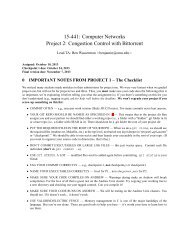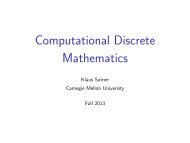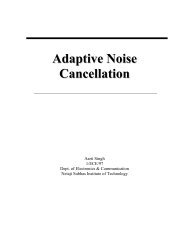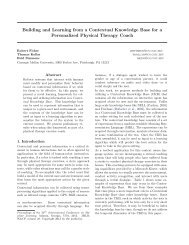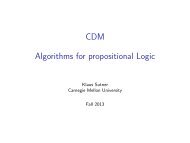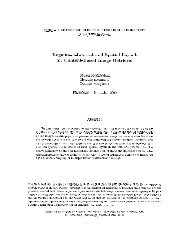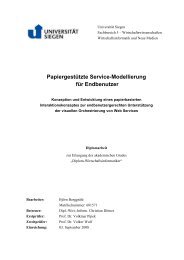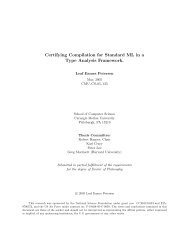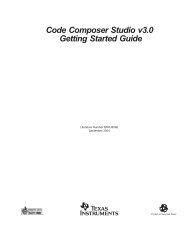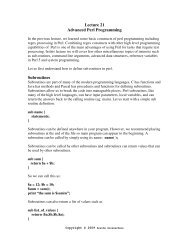Lecture 19: Data Structures (Trees, Graphs) - Carnegie Mellon ...
Lecture 19: Data Structures (Trees, Graphs) - Carnegie Mellon ...
Lecture 19: Data Structures (Trees, Graphs) - Carnegie Mellon ...
Create successful ePaper yourself
Turn your PDF publications into a flip-book with our unique Google optimized e-Paper software.
UNIT 7A<br />
Organizing <strong>Data</strong><br />
(<strong>Trees</strong> and <strong>Graphs</strong>)<br />
1<br />
Summary of Search Techniques<br />
Technique Setup Cost Search Cost<br />
Linear search 0, since we’re O(n)<br />
given the list<br />
Binary search O(n log n) O(log n)<br />
to sort the list<br />
Hash table O(n) to fill the<br />
buckets<br />
O(1)<br />
2<br />
1
<strong>Trees</strong><br />
3<br />
<strong>Trees</strong><br />
• A tree is a hierarchical data structure.<br />
– Every tree has a node called the root.<br />
– Each node can have 1 or more nodes as children.<br />
– A node that has no children is called a leaf.<br />
• A common tree in computing is a binary tree.<br />
– A binary tree consists of nodes that have at most 2<br />
children.<br />
– A complete binary tree has the maximum number of<br />
nodes on each of its levels.<br />
• Applications: data compression, file storage, game<br />
trees<br />
4<br />
2
Binary Tree<br />
24<br />
84<br />
41 96<br />
50<br />
98<br />
13<br />
37<br />
Which one is the root?<br />
Which ones are the leaves?<br />
Is this a complete binary tree?<br />
What is the height of this tree?<br />
5<br />
Binary Tree<br />
24<br />
84<br />
41 96<br />
50<br />
98<br />
13<br />
37<br />
The root has the data value 84.<br />
There are 4 leaves in this binary tree: 13, 37, 50, 98.<br />
This binary tree is not complete.<br />
This binary tree has height 3 (depends on the assumed definition. Some<br />
definitions would regard it as 4).<br />
6<br />
3
Binary <strong>Trees</strong>: Implementation<br />
• One common implementation of binary trees uses<br />
nodes like a linked list does.<br />
– Instead of having a “next” pointer, each node has a<br />
“left” pointer and a “right” pointer.<br />
45<br />
Level 1<br />
31 70<br />
Level 2<br />
<strong>19</strong> 38 86<br />
Level 3<br />
7<br />
Using Nested Arrays<br />
• Languages like Ruby do not let programmers manipulate pointers<br />
explicitly.<br />
• We could use Ruby arrays to implement binary trees. For example:<br />
[45, left, right]<br />
45<br />
Level 1<br />
31 70<br />
<strong>19</strong> 38 86<br />
Level 2<br />
Level 3<br />
[45,[31,left,right],[70,left,right]]<br />
[45, [31, [<strong>19</strong>,[],[]], [38,[],[]]],<br />
[70,[], [86, [], []]]<br />
]<br />
[] stands for an empty tree<br />
Arrows point to subtrees<br />
8<br />
4
Using One Dimensional Arrays<br />
• We could also use a flat array.<br />
45<br />
Level 1<br />
31 70<br />
Level 2<br />
<strong>19</strong> 38 86<br />
Level 3<br />
45 31 70 <strong>19</strong> 38 86<br />
Level 1 Level 2 Level 3<br />
9<br />
Dynamic Set Operations<br />
• Insert<br />
• Delete<br />
• Search<br />
• Find min/max<br />
• ...<br />
Choosing a specific data structure has consequences on which<br />
operations can be performed faster.<br />
10<br />
5
Binary Search Tree (BST)<br />
• A binary search tree (BST) is a binary tree<br />
such that<br />
– All nodes to the left of any node have data<br />
values less than that node<br />
– All nodes to the right of any node have data<br />
values greater than that node<br />
11<br />
Inserting into a BST<br />
• For each data value that you wish to insert<br />
into the binary search tree:<br />
– Start at the root and compare the new data<br />
value with the root.<br />
– If it is less, move down left. If it is greater,<br />
move down right.<br />
– Repeat on the child of the root until you end<br />
up in a position that has no node.<br />
– Insert a new node at this empty position.<br />
12<br />
6
Example<br />
• Insert: 84, 41, 96, 24, 37, 50, 13, 98<br />
84<br />
41 96<br />
24<br />
50<br />
98<br />
13<br />
37<br />
15110 Principles of Computing,<br />
<strong>Carnegie</strong> <strong>Mellon</strong> University<br />
13<br />
Using a BST<br />
• How would you search for an element in a<br />
BST?<br />
84<br />
41 96<br />
24<br />
50<br />
98<br />
13<br />
37<br />
15110 Principles of Computing,<br />
<strong>Carnegie</strong> <strong>Mellon</strong> University<br />
14<br />
7
Searching a BST<br />
• For the key (data value) that you wish to<br />
search<br />
– Start at the root and compare the key with the<br />
root. If equal, key found.<br />
– Otherwise<br />
• If it is less, move down left. If it is greater, move<br />
down right. Repeat search on the child of the root.<br />
• If there is no non‐empty subtree to move to, then<br />
key not found.<br />
15110 Principles of Computing,<br />
<strong>Carnegie</strong> <strong>Mellon</strong> University<br />
15<br />
Exercises<br />
• How you would find the minimum and<br />
maximum elements in a BST?<br />
• What would be output if we walked the tree<br />
in left‐node‐right order?<br />
15110 Principles of Computing,<br />
<strong>Carnegie</strong> <strong>Mellon</strong> University<br />
16<br />
8
Max‐Heaps<br />
• A max‐heap is a binary tree such that<br />
– The largest data value is in the root<br />
– For every node in the max‐heap, its children<br />
contain smaller data.<br />
– The max‐heap is an almost‐complete binary tree.<br />
• An almost‐complete binary tree is a binary<br />
tree such that every level of the tree has the<br />
maximum number of nodes possible except possibly<br />
the last level, where its nodes are attached as far left<br />
as possible.<br />
15110 Principles of Computing,<br />
<strong>Carnegie</strong> <strong>Mellon</strong> University<br />
17<br />
Heap Example<br />
84<br />
41 56<br />
24<br />
10<br />
30<br />
38<br />
13<br />
7<br />
18<br />
9
BSTs vs. Max‐Heaps<br />
• Which tree is designed for easier searching?<br />
• Which tree is designed for retrieving the<br />
maximum value quickly?<br />
• A heap is guaranteed to be “balanced”<br />
(complete or almost‐complete).<br />
What about a BST?<br />
15110 Principles of Computing,<br />
<strong>Carnegie</strong> <strong>Mellon</strong> University<br />
<strong>19</strong><br />
• BST with n elements<br />
BSTs vs Max‐Heaps<br />
– Insert and Search:<br />
• worst case O(log n) if tree is “balanced”<br />
• worst case O(n) in general since tree could have one<br />
node per level<br />
• Max‐Heap with n elements<br />
– Insert and Remove‐Max<br />
• worst case O(log n) since tree is always “balanced”<br />
– Find‐Max<br />
• worst case O(1) since max is always at the root<br />
15110 Principles of Computing,<br />
<strong>Carnegie</strong> <strong>Mellon</strong> University<br />
20<br />
10
<strong>Graphs</strong><br />
21<br />
<strong>Graphs</strong><br />
• A graph is a data structure that consists of a set of<br />
vertices and a set of edges connecting pairs of the<br />
vertices.<br />
– A graph doesn’t have a root, per se.<br />
– A vertex can be connected to any number of other vertices<br />
using edges.<br />
– An edge may be bidirectional or directed (one‐way).<br />
– An edge may have a weight on it that indicates a cost for<br />
traveling over that edge in the graph.<br />
• Applications: computer networks, transportation<br />
systems, social relationships<br />
22<br />
11
Undirected and Directed <strong>Graphs</strong><br />
0<br />
7<br />
0<br />
7<br />
6<br />
1<br />
4<br />
5<br />
3<br />
2<br />
3<br />
6<br />
1<br />
4<br />
2<br />
5<br />
9<br />
3<br />
2<br />
3<br />
from<br />
to<br />
0 1 2 3<br />
0 0 6 7 5<br />
1 6 0 4 ∞<br />
2 7 4 0 3<br />
3 5 ∞ 3 0<br />
from<br />
to<br />
0 1 2 3<br />
0 0 6 7 5<br />
1 ∞ 0 4 ∞<br />
2 2 ∞ 0 3<br />
3 ∞ ∞ 9 0<br />
23<br />
<strong>Graphs</strong> in Python<br />
from<br />
0<br />
6<br />
4<br />
1<br />
to<br />
7<br />
5<br />
3<br />
0 1 2 3<br />
0 0 6 7 5<br />
2<br />
3<br />
1 6 0 4 ∞<br />
2 7 4 0 3<br />
3 5 ∞ 3 0<br />
graph =<br />
[ [ 0, 6, 7, 5 ],<br />
[ 6, 0, 4, float(‘inf’) ],<br />
[ 7, 4, 0, 3],<br />
[ 5, float(‘inf’), 3, 0] ]<br />
24<br />
12
10<br />
0<br />
An Undirected Weighted Graph<br />
1<br />
12<br />
6<br />
7<br />
8<br />
3<br />
2<br />
4<br />
5<br />
9<br />
7<br />
4<br />
11<br />
0 1 2 3 4 5 6<br />
Pitt. Erie Will. S.C. Harr. Scr. Phil.<br />
7<br />
6<br />
5<br />
3<br />
from<br />
0 1 2 3 4 5 6<br />
0 0 10 ∞ 8 7 ∞ ∞<br />
1 10 0 12 7 ∞ ∞ ∞<br />
2 ∞ 12 0 6 ∞ 7 5<br />
3 8 7 6 0 9 4 ∞<br />
4 7 ∞ ∞ 9 0 ∞ 11<br />
5 ∞ ∞ 7 4 ∞ 0 3<br />
6 ∞ ∞ 5 ∞ 11 3 0<br />
vertices<br />
edges<br />
to<br />
25<br />
Original Graph<br />
10<br />
Pitt<br />
Erie<br />
8<br />
12<br />
7<br />
6<br />
S.C.<br />
Will.<br />
9<br />
4<br />
5<br />
7<br />
Phil.<br />
Scr.<br />
3<br />
7 Harr.<br />
11<br />
26<br />
13
A Minimal Spanning Tree<br />
Will.<br />
Pitt<br />
Erie<br />
8<br />
7<br />
S.C.<br />
4<br />
5<br />
Phil.<br />
Scr.<br />
3<br />
7<br />
Harr.<br />
The minimum total cost to connect all vertices using edges from<br />
the original graph without using cycles. (minimum total cost = 34)<br />
27<br />
Original Graph<br />
10<br />
Pitt<br />
Erie<br />
8<br />
12<br />
7<br />
6<br />
S.C.<br />
Will.<br />
9<br />
4<br />
5<br />
7<br />
Phil.<br />
Scr.<br />
3<br />
7 Harr.<br />
11<br />
28<br />
14
Shortest Paths from Pittsburgh<br />
10<br />
Pitt<br />
Erie<br />
10<br />
8<br />
7<br />
6<br />
S.C.<br />
Will.<br />
Harr.<br />
4<br />
8<br />
14<br />
7<br />
Phil.<br />
Scr.<br />
3<br />
15<br />
12<br />
The total costs of the shortest path from Pittsburgh to every other<br />
location using only edges from the original graph.<br />
29<br />
Graph Algorithms<br />
• There are algorithms to compute the minimal spanning<br />
tree of a graph and the shortest paths for a graph.<br />
• There are algorithms for other graph operations:<br />
– If a graph represents a set of pipes and the number represent<br />
the maximum flow through each pipe, then we can determine<br />
the maximum amount of water that can flow through the<br />
pipes assuming one vertex is a “source” (water coming into<br />
the system) and one vertex is a “sink” (water leaving the<br />
system)<br />
– Many more graph algorithms... very useful to solve real life<br />
problems.<br />
30<br />
15



